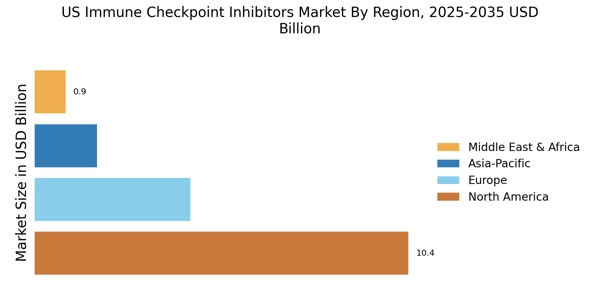Rising Incidence of Cancer
The increasing prevalence of various cancer types in the United States is a primary driver for the US Immune Checkpoint Inhibitors Market. According to the American Cancer Society, an estimated 1.9 million new cancer cases are expected to be diagnosed in 2025. This alarming statistic underscores the urgent need for effective treatment options, propelling the demand for immune checkpoint inhibitors. These therapies have shown promising results in improving patient outcomes, particularly in melanoma, lung cancer, and other malignancies. As healthcare providers seek innovative solutions to combat cancer, the US Immune Checkpoint Inhibitors Market is likely to experience substantial growth, driven by the need for advanced therapeutic modalities that can enhance survival rates and quality of life for patients.
Advancements in Immunotherapy
Technological advancements in immunotherapy are significantly influencing the US Immune Checkpoint Inhibitors Market. The development of novel agents and combination therapies has expanded the therapeutic landscape, offering new hope for patients with previously untreatable cancers. For instance, the introduction of PD-1 and CTLA-4 inhibitors has revolutionized treatment protocols, leading to improved efficacy and safety profiles. The National Cancer Institute reports that the market for immunotherapy is projected to reach USD 100 billion by 2026, indicating a robust growth trajectory. These advancements not only enhance treatment options but also stimulate further research and development, thereby reinforcing the market's expansion and attracting investment from pharmaceutical companies.
Investment in Cancer Research
The surge in investment for cancer research is a significant driver of the US Immune Checkpoint Inhibitors Market. Public and private funding for cancer research initiatives has increased, leading to the discovery of new therapeutic targets and treatment modalities. The National Institutes of Health (NIH) has allocated substantial resources towards cancer research, with funding exceeding USD 6 billion annually. This financial support fosters innovation and accelerates the development of immune checkpoint inhibitors, enhancing their availability in the market. As research continues to unveil new insights into cancer biology and treatment mechanisms, the US Immune Checkpoint Inhibitors Market is poised for growth, driven by the continuous influx of novel therapies and clinical trials.
Growing Awareness and Education
The increasing awareness and education surrounding cancer treatments, particularly immunotherapy, are driving the US Immune Checkpoint Inhibitors Market. Healthcare professionals and patients are becoming more informed about the benefits and availability of immune checkpoint inhibitors, leading to higher adoption rates. Educational initiatives by medical organizations and advocacy groups have played a pivotal role in disseminating information about these therapies. As patients become more proactive in seeking treatment options, the demand for immune checkpoint inhibitors is expected to rise. This heightened awareness not only influences treatment decisions but also encourages healthcare providers to consider these innovative therapies as first-line options, further propelling market growth.
Regulatory Approvals and Support
Regulatory bodies in the United States, such as the FDA, play a crucial role in shaping the US Immune Checkpoint Inhibitors Market. The expedited approval processes for innovative therapies have facilitated quicker access to life-saving treatments for patients. Recent approvals of new immune checkpoint inhibitors have bolstered market confidence and encouraged pharmaceutical companies to invest in research and development. The FDA's commitment to supporting breakthrough therapies is evident in its designation of several immune checkpoint inhibitors as breakthrough therapies, which streamlines the approval process. This regulatory environment fosters innovation and enhances the market's growth potential, as more effective treatments become available to combat various cancers.


















Leave a Comment